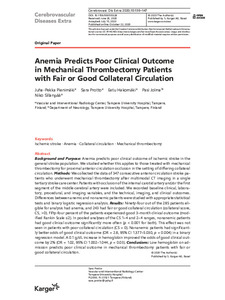Anemia Predicts Poor Clinical Outcome in Mechanical Thrombectomy Patients with Fair or Good Collateral Circulation
Pienimäki, Juha-Pekka; Protto, Sara; Hakomäki, Eetu; Jolma, Pasi; Sillanpää, Niko (2020)
Pienimäki, Juha-Pekka
Protto, Sara
Hakomäki, Eetu
Jolma, Pasi
Sillanpää, Niko
2020
Julkaisun pysyvä osoite on
https://urn.fi/URN:NBN:fi:tuni-202205034280
https://urn.fi/URN:NBN:fi:tuni-202205034280
Kuvaus
Peer reviewed
Tiivistelmä
Background and Purpose: Anemia predicts poor clinical outcome of ischemic stroke in the general stroke population. We studied whether this applies to those treated with mechanical thrombectomy for proximal anterior circulation occlusion in the setting of differing collateral circulation. Methods: We collected the data of 347 consecutive anterior circulation stroke patients who underwent mechanical thrombectomy after multimodal CT imaging in a single tertiary stroke care center. Patients with occlusion of the internal carotid artery and/or the first segment of the middle cerebral artery were included. We recorded baseline clinical, laboratory, procedural, and imaging variables, and the technical, imaging, and clinical outcomes. Differences between anemic and nonanemic patients were studied with appropriate statistical tests and binary logistic regression analysis. Results: Ninety-four out of the 285 patients eligible for analysis had anemia, and 243 had fair or good collateral circulation (collateral score, CS, >0). Fifty-four percent of the patients experienced good 3-month clinical outcome (modified Rankin Scale ≤2). In pooled analyses of the CS 1-4 and 2-4 ranges, nonanemic patients had good clinical outcome significantly more often (p < 0.001 for both). This effect was not seen in patients with poor collateral circulation (CS = 0). Nonanemic patients had significantly better odds of good clinical outcome (OR = 2.6, 95% CI 1.377-5.030, p = 0.004) in a binary regression model. A 0.1 g/dL increase in hemoglobin improved the odds of good clinical outcome by 2% (OR = 1.02, 95% CI 1.002-1.044, p = 0.03). Conclusions: Low hemoglobin on admission predicts poor clinical outcome in mechanical thrombectomy patients with fair or good collateral circulation.
Kokoelmat
- TUNICRIS-julkaisut [16858]
